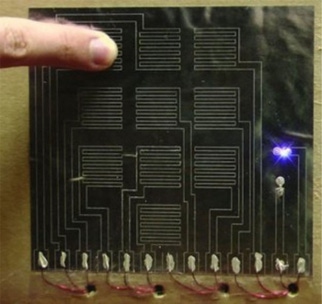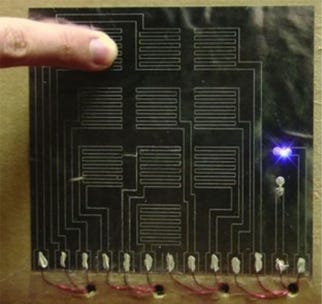Paper labels and packaging interacts with customers
January 30, 2014

For many consumer goods and beverage companies, labels allowing customers to effectively interact with their brand, are considered the Holy Grail. Similarly, they are seeking solutions to allow their boxed products to communicate with the consumer. With a newly developed application for metallize
D1 - Paper labelsrrrr.jpg
d paper, this ambitious goal might be closer than the industry could have hoped for.
Based on research carried out at Harvard University (researchers Mazzeo, Kalb, Chan, Killian, Bloch and Whitesides) and collaborations with institutes in Portugal and France, a specially developed paper has been demonstrated to yield sufficient capacitive properties to be used as a "touch pad", entirely made of paper. After a straightforward laser etching, followed by connection with cheap electronic interfaces, the paper can be used to detect consumer's "touch" like a smart phone's touch pad.
This product, however, is at a fraction of the production cost. Also, by using metallized paper, which is re-pulpable like ordinary paper, it is environmentally friendly. Other advantages in this option include that metallized paper can be easily glued onto surfaces (like a label) or folded or laminated in three-dimensional shapes (like boxes), unlike glass surfaces or thick films.
The researchers and AR Metallizing envisaged and tested prototypes for applications such as: touch sensitive labels, interactive book covers, food labels and boxes, interactive games on cereal boxes, multi-digit disposable code pads on shipping boxes, and even entire paper-based keyboards.
How it works: when a person touches the paper-based surface, the capacitance increases. When connected to external circuitry and electronics (all of which can be cheap and multi-use), this change in capacitance can be detected and messages or signals transferred. Through etching, multiple, discrete capacitors can be put on two simple metallized paper sheets, placed next to each other. Testing showed that over 2000 touches are possible without altering the functioning. These technological and economical breakthroughs allow for the "smart package" to be environmentally green. It can be disposed of after use, with no impact on the environment.
For AR Metallizing, the global leader in producing metallized paper for applications in labels and packaging, this is an exciting new step in leveraging its technology in new applications. The lead researcher, now at Rutgers Aaron Mazzeo, states, "We were interested in designing systems that use low cost materials to provide high-tech functionality." The Director of Business and Product Development for ARM U.S.A., Joe Formosa, notes, "The innovative approach of this research helped us unveil the capacitative properties of our material, which we could then substantially improve.
The technology clearly contributes to our ambition to provide CPG companies with innovative packaging materials, which are sustainable and low cost." Martin Raeymakers, CCO, of ARM Belgium adds, "Metallized paper has proven its value as a highly value add packaging and label material based on its aesthetics and premium look for years. By our ability to unlock research skills from our three global locations, we are able to propose solutions, which leverage functional properties of our technology, such as this capacitor, but also IR and UV shielding. This opens up new opportunities for our clients."
The research is unique as there are no descriptions in literature for simple methods of receiving inputs or keystrokes on paper - based substrates. AR Metallizing is currently working with select companies to develop concrete applications in packaging.
AR Metallizing, 508-541-7759, www.armtallizing.com
About the Author(s)
You May Also Like


